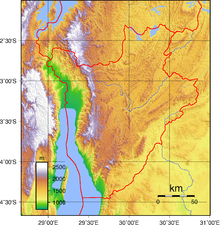Climate of Burundi

TheclimateofBurundiisequatorialin nature, and is marked by high mean annual temperatures, small temperature ranges, and rainfall throughout the year.[1]Despite this, there is still considerable daily variation in temperature and rainfall across the country, depending on altitude.[2]
Burundi is located on theAlbertine Rift,the western extension of theEast African Rift.Altitudes in the country vary between 775 metres or 2,543 feet atLake Tanganyikato 2,684 metres or 8,806 feet atMount Heha.[3]Burundi's generally high elevation produces relatively mild temperatures, with an average temperature of 21 °C or 70 °F throughout the year in the central plateau. At lower areas, such as the capital,Bujumbura,and Lake Tanganyika, the average annual temperature increases slightly, to 23 °C or 73 °F; while at higher altitudes, it decreases to 16 °C or 61 °F.[4][3]
Burundi experiences itsdry seasonbetween May and August, with a shorter dry season also occurring between January and February.[4]Itsrainy seasonoccurs between February and May, and September to November.[2][5]Annual precipitation stands at between 1,500 and 1,800 millimetres (60 and 70 in) in high-elevation areas, though it drops to 1,000 millimetres or 40 inches on the shores of Lake Tanganyika and various depressions.[4][2]The rainiest part of the country is the north-east; rainfall in higher areas can be almost double that of what is found on lower ground.[3][6]As a result of its rainfall, agriculture in Burundi — which employs between 80% and 90% of the country's workforce — is heavily reliant uponrain-fed crop production.[7][8][5]
Burundi's mild climate and adequate rainfall makes it a suitable location forintensive agriculture,though the impact of climate change is making rainfall less predictable.[5]Burundi has experienced alternating cycles of excess and deficit rainfall in nearly every decade since the 1950s. This has included severefloodsin 2006 and 2007, anddroughtsfrom 1999 to 2000, and in 2005.[2]Burundi has been identified as one of six African countries considered to be highly vulnerable to droughts.[9]
References
[edit]- ^McKnight, Tom L.; Hess, Darrel (2000).Physical geography: a landscape appreciation(6th ed.). Upper Saddle River:Prentice Hall.pp. 205–208.ISBN0-13-020263-0.OCLC43724491.
- ^abcdBaramburiye, Juvent; Kyotalimye, Miriam; Thomas, Timothy S.; Waithaka, Michael (2013). "Burundi". In Waithaka, Michael; Nelson, Gerald C.; Thomas, Timothy S.; Kyotalimye, Miriam (eds.).East African agriculture and climate change: A comprehensive analysis.Washington, D.C.:International Food Policy Research Institute.pp. 55–87.Retrieved25 March2023.
- ^abcNkurunziza, Hermenegilde; Gebhardt, Albrecht; Pilz, Jürgen (2010)."Bayesian modelling of the effect of climate on malaria in Burundi".Malaria Journal.9(114): 114.doi:10.1186/1475-2875-9-114.PMC2885398.PMID20429877.
- ^abcLemarchand, René; Kahan Eggers, Ellen (17 March 2023)."Burundi".Britannica.Retrieved25 March2023.
- ^abcJeníček, Vladimír; Grofová, Šárka (2015)."Least developed countries - the case of Burundi"(PDF).Agricultural Economics.61(5): 234–247 – via Czech Academy of Agricultural Sciences.
- ^Lawin, Agnidé Emmanuel; Manirakiza, Célestin; Lamboni, Batablinlè (7 March 2018)."Trends and changes detection in rainfall, temperature and wind speed in Burundi".Journal of Water and Climate Change.10(4): 852–870.doi:10.2166/wcc.2018.155– viaIWA Publishing.
- ^Nyairo, Risper; Machimura, Takashi; Matsui, Takanori (24 May 2020)."A Combined Analysis of Sociological and Farm Management Factors Affecting Household Livelihood Vulnerability to Climate Change in Rural Burundi".Sustainability.12(10): 4296.doi:10.3390/su12104296.
- ^Batungwanayo, Pacifique; Habarugira, Viateur; Vanclooster, Marnik; Ndimubandi, Jean; Koropitan, Alan F.; de Dieu Nkurunziza, Jean (28 February 2023)."Confronting climate change and livelihood: smallholder farmers' perceptions and adaptation strategies in northeastern Burundi".Regional Environmental Change.23(27).doi:10.1007/s10113-022-02018-7.S2CID257222624.
- ^Naumann, G.; Barbosa, P.; Garrote, L.; Iglesias, A.; Vogt, J. (6 May 2014)."Exploring drought vulnerability in Africa: an indicator based analysis to be used in early warning systems".Hydrology and Earth System Sciences.18(5): 1591–1604.doi:10.5194/hess-18-1591-2014– viaCopernicus Publications.
